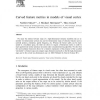Free Online Productivity Tools
i2Speak
i2Symbol
i2OCR
iTex2Img
iWeb2Print
iWeb2Shot
i2Type
iPdf2Split
iPdf2Merge
i2Bopomofo
i2Arabic
i2Style
i2Image
i2PDF
iLatex2Rtf
Sci2ools
IJON
2002
2002
Curved feature metrics in models of visual cortex
We study the relation between maps of a high-dimensional stimulus manifold onto an essentially two-dimensional cortical area and low-dimensional maps of stimulus features such as centroid position, orientation, spatial frequency, etc. Whereas the former safely can be represented in a Euclidean space, the latter are shown to require a Riemannian metric in order to reach qualitatively similar stationary structures under a standard learning algorithm. We show that the non-Euclidean framework allows for a tentative explanation of the presence of the so-called "pinwheels" in feature maps and compare maps obtained numerically in the at high-dimensional maps and in the curved low-dimensional case. c 2002 Published by Elsevier Science B.V.
| Added | 22 Dec 2010 |
| Updated | 22 Dec 2010 |
| Type | Journal |
| Year | 2002 |
| Where | IJON |
| Authors | Norbert Michael Mayer, J. Michael Herrmann, Theo Geisel |
Comments (0)

